Late Holocene Glacial Fluctuations of Schiaparelli Glacier at Monte Sarmiento Massif, Tierra del Fuego (54°24′ S)
Abstract
1. Introduction
2. Materials and Methods
2.1. Study Site and Regional Climate Conditions
2.2. Methods for Dating Glacial Deposits (Based on Tree- Rings and Radicarbon Dates)
- (i)
- the pith of the tree was not reached or missed during sampling (pith offset);
- (ii)
- the number of tree-rings that are lost when the tree is sampled at a distinct elevation above the ground;
- (iii)
- the timespan (ecesis time) between deglaciation (surface exposure), moraine stabilization, soil development, and the colonization by the first trees; and
- (iv)
- the probability that the oldest tree was sampled.
2.2.1. Establishment of Tree Ring Site Chronology and Evaluation of Missing Rings
2.2.2. Growth Rate Modeling of Nothofagus spp.
2.2.3. Estimation of the Site-Specific Ecesis Time
2.2.4. First-Generation Trees
2.2.5. Radiocarbon Ages
3. Results
3.1. Dating Uncertainty Introduced by the Estimation of the Pith Offset (PO)
3.2. Growth Rates of Nothofagus Spp.
3.3. Site-Specific Ecesis Time
3.4. Tree-Ring-Based Moraine Dates
3.5. Radiocarbon Dates/Glacier Chronology of Southern America
4. Discussion
4.1. Late Holocene Glacial Oscillations in Southernmost America
4.2. Variables that Influence the Uncertainty Value for Tree-Ring-Based Moraine Dating
4.2.1. Estimations of the Pith Offset (PO)
4.2.2. Height–Age Calibration
4.2.3. Ecesis Time
5. Conclusions
Author Contributions
Funding
Acknowledgments
Conflicts of Interest
Appendix A
| Acquisition Date | Path/Row Tile No. | Product Identifier Number (USGS 1, LP DAAC 2, ESA 3) |
|---|---|---|
| 1973/02/08 | 244/098 | LM01_L1GS_244098_19730209_20180427_01_T2 |
| 1986/02/10 | 228/098 | LT05_L1TP_228098_19860210_20170218_01_T1 |
| 1986/02/26 | 228/098 | LT05_L1TP_228098_19860226_20170218_01_T1 |
| 1992/04/23 | 228/098 | LT04_L1GS_228098_19920423_20170123_01_T2 |
| 1992/05/09 | 228/098 | LT04_L1GS_228098_19920509_20170122_01_T2 |
| 1998/04/23 | 229/098 | LT05_L1TP_229098_19980423_20161224_01_T1 |
| 2000/03/28 | 228/098 | LE07_L1TP_228098_20000328_20170212_01_T1 |
| 2003/04/22 | 228/098 | LE07_L1TP_228098_20030422_20170125_01_T1 |
| 2005/02/14 | 228/098 | LT05_L1TP_228098_20050214_20161127_01_T1 |
| 2005/11/14 | 228/098 | AST_L1T_00311142005141915_20150511225344_35217 |
| 2007/03/08 | 228/098 | LT05_L1TP_228098_20070308_20161116_01_T1 |
| 2009/02/01 | 228/098 | LE07_L1TP_228098_20090201_20161222_01_T1 |
| 2010/11/10 | 228/098 | AST_L1T_00311102010143157_20150603181517_4666 |
| 2013/09/16 | 228/098 | LC08_L1TP_228098_20130916_20170502_01_T1 |
| 2016/05/25 | T19FCV | S2A_MSIL1C_20160525T141052_N0202_R110_T19FCV_20160525T142007 |
| 2017/03/19 | 228/098 | LC08_L1TP_228098_20170319_20170328_01_T1 |
| 2018/05/17 | T19FCV | S2B_MSIL1C_20180517T140049_N0206_R067_T19EET_20180517T191133 |
| 2019/02/04 | T19FCV | S2B_MSIL1C_20190204T141049_N0207_R110_T19FCV_20190204T190715 |
Appendix B
| Location Lat/Long (Name) | Uncalibrated Age (14C BP) | Calibrated Age (cal. Yr BP) | Calibrated Age (cal. Yr BCE/CE) | Reference |
|---|---|---|---|---|
| 48°28′ S/72°20′ W (Narváez) | 925 ± 30 | 822 (782) 727 | 1128 (1168) 1223 | Masiokas et al. 2001, 2009 [26,142] |
| 720 ± 35 | 676 (631) 623 | 1274 (1319) 1327 | ||
| 655 ± 30 | 650 (606) 581 | 1300 (1344) 1369 | ||
| 645 ± 45 | 656 (602) 536 | 1348 (1394) 1414 | ||
| 48°30′ S/72°52′ W (Ofhidro Norte) | 900 ± 95 | 820 (698) 550 | 1130 (1152) 1140 | Mercer 1970 [34] |
| 48°34′ S/72°05′ W (Huemul-Mellizo Norte) | 465 ± 65 | 545 (469) 421 | 1405 (1481) 1529 | Röthlingsberger 1986 [143] |
| 48°37′ S/73°54′ W Bernardo | 270 ± 90 | 470 (267) 132 | 1480 (1683) 1818 | Mercer 1970 [34] |
| 48°39′ S/73°11′ W (Bravo) | 665 ± 80 | 685 (604) 508 | 1265 (1346) 1442 | Röthlingsberger 1986 [143] |
| 270 ± 100 | 472 (265) 131 | 1478 (1685) 1819 | ||
| 165 ± 50 | 155 (133) 0 | 1795 (1817) 1950 | ||
| 48°50′ S/73°04′ W (Occidental [Hammick]) | 2800 ± 100 | 3169 (2883) 2717 | −1220 (−934) −768 | Mercer 1970 [34] |
| 2300 ± 100 | 2541 (2261) 2002 | −591 (−311) −52 | ||
| 2070 ± 95 | 2186 (2000) 1784 | −236 (−50) 166 | ||
| 48°53′ S/73°08′ W (O’Higgins) | 790 ± 55 | 767 (686) 631 | 1183 (1264) 1319 | Röthlingsberger 1986 [143] |
| 345 ± 55 | 495 (386) 283 | 1455 (1564) 1667 | ||
| 49°19′ S/73°01′ W (Torre) | 800 ± 85 | 810 (696) 552 | 1140 (1254) 1398 | Mercer 1965 [103] |
| 49°42′ S/73°17′ W (Upsala) | 2565 (2465) 2365 | −615 (−515) −415 | Strelin et al. 2014 [14] 1 Mercer 1965, 1970 [34,103]; Aniya 1995 [102] | |
| 2540 (2450) 2360 | −590 (−500) −410 | |||
| 1410 (1275) 1140 | 540 (675) 810 | |||
| 1240 (1125) 1010 | 710 (825) 940 | |||
| 725 (700) 675 | 1225 (1250) 1275 | |||
| 470 (415) 360 | 1480 (1535) 1590 | |||
| 2310 ± 120 | 2546 (2280) 1896 | −596 (−330) −54 | ||
| 1620 ± 90 | 1621 (1474) 1305 | 329 (476) 645 | ||
| 1430 ± 155 | 1292 (1594) 959 | 356 (658) 991 | ||
| 49°47′ S/ (Dos Lagos) | 1595 ± 100 | 1626 (1455) 1289 | 324 (495) 661 | Mercer 1965 [103] |
| 49°57′ S/ (Cerro Norte) | 390 ± 85 | 535 (398) 278 | 1415 (1552) 1672 | Mercer 1965 [103] |
| 49°58′ S/73°21′ W Agassiz Este Valley | 2255 (2175) 2095 | −305 (−225) −145 | Strelin et al. 2014 [14] 1 | |
| 50°25′ S/73°18′ W (Ameghino) | 480 ± 80 | 560 (475) 311 | 1390 (1475) 1639 | Aniya 1996 [144], Masiokas et al. 2001 [142] |
| 380 ± 80 | 524 (394) 278 | 1426 (1556) 1672 | ||
| 315 ± 30 | 448 (377) 357 | 1502 (1573) 1593 | ||
| 290 ± 30 | 330 (307) 277 | 1620 (1643) 1673 | ||
| 285 ± 40 | 340 (304) 264 | 1610 (1646) 1686 | ||
| 150 ± 30 | 150 (104) 0 | 1800 (1846) 1950 | ||
| 50°29′ S/73°11′ W (Perito Moreno) | 800 ± 80 | 804 (695) 555 | 1146 (1255) 1395 | Aniya and Sato 1995 [102] |
| 50°45′ S/73°11′ W (Dickson) | 520 ± 35 | 548 (518) 493 | 1402 (1432) 1457 | Strelin et al. 2014 [14] 1 |
| 50°56′ S/73°07′ W (Perro) | 1730 ± 80 | 1750 (1599) 1404 | 200 (351) 543 | Röthlingsberger 1986 [143] |
| 795 ± 80 | 803 (691) 553 | 1147 (1259) 1397 | ||
| 345 ± 100 | 525 (361) 239 | 1425 (1589) 1711 | ||
| 295 ± 75 | 493 (313) 239 | 1457 (1637) 1711 | ||
| 260 ± 50 | 231 (228) 138 | 1719 (1722) 1812 | ||
| 205 ± 50 | 301 (179) 131 | 1649 (1771) 1819 | ||
| 51°01′ S/73°04′ W (Francés) | 675 ± 45 | 663 (606) 550 | 1287 (1344) 1400 | Röthlingsberger 1986 [143] |
| 235 ± 45 | 322 (199) 133 | 1628 (1751) 1817 | ||
| 51°20′ S/73°15′ W (Tyndall) | 1370 ± 80 | 1371 (1228) 1060 | 579 (722) 890 | Aniya 1995 [102] |
| 1330 ± 80 | 1320 (1197) 1050 | 630 (753) 900 | ||
| 54°25′ S/70°43′ W (Ema) | 1288 ± 75 | 1297 (1158) 1046 | 653 (792) 904 | Strelin et al. 2008 [15] |
| 695 ± 95 | 741 (619) 506 | 1209 (1331) 1444 | ||
| 379 ± 75 | 520 (395) 276 | 1430 (1555) 1671 | ||
| 335 ± 70 | 500 (373) 271 | 1450 (1577) 1679 | ||
| 251 ± 70 | 335 (217) 131 | 1615 (1733) 1819 | ||
| 54°47′ S/69°36′ W (Bahía Pía) | 940 ± 70 | 928 (814) 684 | 1022 (1136) 1266 | Kuylenstierna et al. 1996 [13] |
| 675 ± 70 | 683 (607) 518 | 1267 (1343) 1432 | ||
| Paleoclimatic Studies | ||||
| 51°17′ S/72°51′ W (Lago Cipreses) | Moreno et al. 2014 [114] | 54°25′ S/69°35′ W (Marinelli Glacier) | Boyd et al. 2008 [113] | |
| 51°52′ S/72°52′ W (Lago Guanaco) | Moreno et al. 2009, Moy et al. 2008, 2009 [4,145,146] | 54°29′ S/69°37′ W (Marinelli Glacier) | Vanneste et al. 2016 [115] | |
| (54°17′ S/69°17′ W (Almirantazgo fjord) | Betrand et al. 2017 [10] | 54°41′ S/68°02′ W (Las Cotorras mire) | Borromei et al. 2010 [147] | |
| (54°45′ S/68°18′ W) (Navarino Island) | Mauquoy et al. 2004 [148] | 53–55° S (peat: Tierra Australis, Andorra, Karukinka) | Van Bellen et al. 2015 [149] | |
| (54°46′ S/64°18′ W) Isla de los Estados | Ponce 2017 [150] | 50°59′ S–53°09′ S (mire at Puerto del Hambre; Punta Arenas) | Heusser, 1995 [151] | |
Appendix C
| NO# | 14C age | 14C Lab# | cal. BP | NO# | 14C Age | 14C Lab# | cal. BP |
|---|---|---|---|---|---|---|---|
| SC 1 | 2255 ± 15 | UCI-133702 * | 2314 (2230) 2158 | SC 8 | 1750 ± 30 | Poz-94999 | 1702 (1624) 1558 |
| SC 2 | 2165 ± 15 | UCI-133706 | 2155 (2112) 2044 | SC 9 | 1725 ± 15 | UCI-133701 | 1612 (1579) 1538 |
| SC 3 | 2100 ± 15 | UCI-133705 | 2086 (2028) 1999 | SC 10 | 1385 ± 15 | UCI-133708 | 1300 (1281) 1268 |
| SC 4 | 1985 ± 35 | Poz-95001 ** | 1998 (1896) 1825 | SC 11 | 1320 ± 15 | UCI-133704 | 1270 (1231) 1180 |
| SC 5 | 1930 ± 15 | UCI-133709 | 1887 (1837) 1804 | SC 12 | 1215 ± 15 | Poz-95002 | 1112 (1070) 1051 |
| SC 6 | 1770 ± 20 | UCI-133703 | 1703 (1652) 1586 | SC 13 | 1080 ± 15 | UCI-133707 | 960 (944) 926 |
| SC 7 | 1760 ± 35 | Poz-95000 * | 1708 1637) 1557 | SC 14 | 860 ± 30 | Poz-95002 | 676 (725) 773 |
References
- Garreaud, R.; Lopez, P.; Minvielle, M.; Rojas, M. Large-Scale Control on the Patagonian Climate. J. Clim. 2013, 26, 215–230. [Google Scholar] [CrossRef]
- Prohaska, F. The climate of Argentina, Paraguay and Uruguay. In Climates of Central and South America; Schwerdtfeger, W., Ed.; Elsevier: Amsterdam, The Netherlands; Oxford, UK, 1976; pp. 13–112. ISBN 978-0444412713. [Google Scholar]
- Lenaerts, J.T.M.; van den Broeke, M.R.; van Wessem, J.M.; van de Berg, W.J.; van Meijgaard, E.; van Ulft, L.H.; Schaefer, M. Extreme Precipitation and Climate Gradients in Patagonia Revealed by High-Resolution Regional Atmospheric Climate Modeling. J. Clim. 2014, 27, 4607–4621. [Google Scholar] [CrossRef]
- Moy, C.M.; Moreno, P.I.; Dunbar, R.B.; Kaplan, M.R.; Francois, J.-P.; Villalba, R.; Haberzettl, T. Climate Change in Southern South America During the Last Two Millennia. In Past Climate Variability in South America and Surrounding Regions. Developments in Paleoenvironmental Research; Vimeux, F., Sylvestre, F., Khodri, M., Eds.; Springer: Dordrecht, The Netherlands, 2009; Volume 14, pp. 353–393. [Google Scholar] [CrossRef]
- Weidemann, S.S.; Sauter, T.; Kilian, R.; Steger, D.; Butorovic, N.; Schneider, C. A 17-year Record of Meteorological Observations Across the Gran Campo Nevado Ice Cap in Southern Patagonia, Chile, Related to Synoptic Weather Types and Climate Modes. Front. Earth Sci. 2018, 6, 505. [Google Scholar] [CrossRef]
- Carrasco, J.F.; Casassa, G.; Rivera, A. Meteorological and climatological aspect of the Southern Patagonia Icefield. In The Patagonian Icefields: A Unique Natural Laboratory for Environmental and Climate Change Studies; Casassa, G., Sepúlveda, F.V., Sinclair, R.M., Eds.; Springer: Boston, MA, USA, 2002; ISBN 978-1-4613-5174-0. [Google Scholar]
- Smith, R.B.; Evans, J.P. Orographic Precipitation and Water Vapor Fractionation over the Southern Andes. J. Hydrometeorol. 2007, 8, 3–19. [Google Scholar] [CrossRef]
- Meier, W.J.-H.; Grießinger, J.; Hochreuther, P.; Braun, M.H. An Updated Multi-Temporal Glacier Inventory for the Patagonian Andes With Changes Between the Little Ice Age and 2016. Front. Earth Sci. 2018, 6, 131. [Google Scholar] [CrossRef]
- Holmlund, P.; Fuenzalida, H. Anomalous glacier responses to 20th century climatic changes in Darwin Cordillera, southern Chile. J. Glaciol. 1995, 41, 465–473. [Google Scholar] [CrossRef]
- Bertrand, S.; Lange, C.B.; Pantoja, S.; Hughen, K.; van Tornhout, E.; Wellner, J.S. Postglacial fluctuations of Cordillera Darwin glaciers (southernmost Patagonia) reconstructed from Almirantazgo fjord sediments. Quat. Sci. Rev. 2017, 177, 265–275. [Google Scholar] [CrossRef]
- Masiokas, M.H.; Rivera, A.; Espizua, L.E.; Villalba, R.; Delgado, S.; Aravena, J.C. Glacier fluctuations in extratropical South America during the past 1000years. Palaeogeogr. Palaeoclimatol. Palaeoecol. 2009, 281, 242–268. [Google Scholar] [CrossRef]
- Aniya, M. Holocene glaciations of Hielo Patagónico (Patagonia Icefield), South America: A brief review. Geochem. J. 2013, 47, 97–105. [Google Scholar] [CrossRef]
- Kuylenstierna, J.L.; Rosqvist, G.C.; Holmlund, P. Late-Holocene glacier variations in the Cordillera Darwin, Tierra del Fuego, Chile. Holocene 1996, 6, 353–358. [Google Scholar] [CrossRef]
- Strelin, J.A.; Kaplan, M.R.; Vandergoes, M.J.; Denton, G.H.; Schaefer, J.M. Holocene glacier history of the Lago Argentino basin, Southern Patagonian Icefield. Quat. Sci. Rev. 2014, 101, 124–145. [Google Scholar] [CrossRef]
- Strelin, J.; Casassa, G.; Rosqvist, G.; Holmlund, P. Holocene glaciations in the Ema Glacier valley, Monte Sarmiento Massif, Tierra del Fuego. Palaeogeogr. Palaeoclimatol. Palaeoecol. 2008, 260, 299–314. [Google Scholar] [CrossRef]
- Aravena, J.C. Reconstructing Climate Variability Using Tree-Rings and Glacier Fluctuations in the Southern Chilean Andes. Ph.D. Thesis, The University of Western Ontario, London, ON, Canada, 2007. [Google Scholar]
- Lopez, P.; Chevallier, P.; Favier, V.; Pouyaud, B.; Ordenes, F.; Oerlemans, J. A regional view of fluctuations in glacier length in southern South America. Glob. Planet. Chang. 2010, 71, 85–108. [Google Scholar] [CrossRef]
- Karger, D.N.; Conrad, O.; Böhner, J.; Kawohl, T.; Kreft, H.; Soria-Auza, R.W.; Zimmermann, N.E.; Linder, H.P.; Kessler, M. Climatologies at high resolution for the earth’s land surface areas. Sci. Data 2017, 4, 170122. [Google Scholar] [CrossRef] [PubMed]
- Kalnay, E.; Kanamitsu, M.; Kistler, R.; Collins, W.; Deaven, D.; Gandin, L.; Iredell, M.; Saha, S.; White, G.; Woollen, J.; et al. The NCEP/NCAR 40-Year Reanalysis Project. Bull. Am. Meteorol. Soc. 1996, 77, 437–471. [Google Scholar] [CrossRef]
- Solomina, O.N.; Bradley, R.S.; Jomelli, V.; Geirsdottir, A.; Kaufman, D.S.; Koch, J.; McKay, N.P.; Masiokas, M.; Miller, G.; Nesje, A.; et al. Glacier fluctuations during the past 2000 years. Quat. Sci. Rev. 2016, 149, 61–90. [Google Scholar] [CrossRef]
- Grove, J.M. The Little Ice Age; Routledge: London, UK, 2008; ISBN 9780415014496. [Google Scholar]
- Matthews, J.A.; Briffa, K.R. The Little Ice Age: Re—Evaluation of an Evolving Concept. Geogr. Ann. Ser. A Phys. Geogr. 2005, 87, 17–36. [Google Scholar] [CrossRef]
- Schaefer, J.M.; Denton, G.H.; Kaplan, M.; Putnam, A.; Finkel, R.C.; Barrell, D.J.A.; Andersen, B.G.; Schwartz, R.; Mackintosh, A.; Chinn, T.; et al. High-Frequency Holocene Glacier Fluctuations in New Zealand Differ from the Northern Signature. Science 2009, 324, 622–625. [Google Scholar] [CrossRef]
- Jones, P.D.; Briffa, K.R.; Osborn, T.J.; Lough, J.M.; van Ommen, T.D.; Vinther, B.M.; Luterbacher, J.; Wahl, E.R.; Zwiers, F.W.; Mann, M.E.; et al. High-resolution palaeoclimatology of the last millennium: A review of current status and future prospects. Holocene 2009, 19, 3–49. [Google Scholar] [CrossRef]
- Glasser, N.F.; Harrison, S.; Winchester, V.; Aniya, M. Late Pleistocene and Holocene palaeoclimate and glacier fluctuations in Patagonia. Glob. Planet. Chang. 2004, 43, 79–101. [Google Scholar] [CrossRef]
- Masiokas, M.H.; Luckman, B.H.; Villalba, R.; Delgado, S.; Skvarca, P.; Ripalta, A. Little Ice Age fluctuations of small glaciers in the Monte Fitz Roy and Lago del Desierto areas, south Patagonian Andes, Argentina. Palaeogeogr. Palaeoclimatol. Palaeoecol. 2009, 281, 351–362. [Google Scholar] [CrossRef]
- Masiokas, M.H.; Luckman, B.H.; Villalba, R.; Ripalta, A.; Rabassa, J. Little Ice Age fluctuations of Glaciar Río Manso in the North Patagonian Andes of Argentina. Quat. Res. 2010, 73, 96–106. [Google Scholar] [CrossRef]
- Luckman, B.H.; Villalba, R. Assessing the Synchroneity of Glacier Fluctuations in the Western Cordillera of the Americas During the Last Millennium. In Interhemispheric Climate Linkages; Markgraf, V., Ed.; Academic Press: San Diego, CA, USA, 2001; pp. 119–140. ISBN 978-0-12-472670-3. [Google Scholar]
- Clapperton, C.M.; Sugden, D. Holocene glacier fluctuations in South America and Antarctica. Quat. Sci. Rev. 1988, 7, 185–198. [Google Scholar] [CrossRef]
- Kilian, R.; Lamy, F. A review of Glacial and Holocene paleoclimate records from southernmost Patagonia (49–55° S). Quat. Sci. Rev. 2012, 53, 1–23. [Google Scholar] [CrossRef]
- Neukom, R.; Gergis, J.; Karoly, D.J.; Wanner, H.; Curran, M.; Elbert, J.; González-Rouco, F.; Linsley, B.K.; Moy, A.D.; Mundo, I.; et al. Inter-hemispheric temperature variability over the past millennium. Nat. Clim. Chang. 2014, 4, 362–367. [Google Scholar] [CrossRef]
- Ljungqvist, F.C. A new reconstruction of temperature variability in the extra—Tropical northern hemisphere during the last two millennia. Geogr. Ann. Ser. A Phys. Geogr. 2010, 92, 339–351. [Google Scholar] [CrossRef]
- King, P.P. Narrative of the Surveying Voyages of His Majesty’s Ships Adventure and Beagle between the Years 1826 and 1836, Describing Their Examination of the Southern Shores of South America, and the Beagle’s Circumnavigation of the Globe, Volume I. Proceedings of the first Expedition, 1826–30, under the Command of Captain, P. Parker King.; Henry Colburn: London, UK, 1839. [Google Scholar]
- Mercer, J.H. Variations of some Patagonian glaciers since the Late-Glacial: II. Am. J. Sci. 1970, 269, 1–25. [Google Scholar] [CrossRef]
- Bown, F.; Rivera, A.; Zenteno, P.; Bravo, C.; Cawkwell, F. First Glacier Inventory and Recent Glacier Variation on Isla Grande de Tierra Del Fuego and Adjacent Islands in Southern Chile. In Global Land Ice Measurements from Space; Kargel, J.S., Leonard, G.J., Bishop, M.P., Kääb, A., Raup, B.H., Eds.; Springer: Berlin/Heidelberg, Germany, 2014; pp. 661–674. [Google Scholar]
- Mercer, J.H. Southern Hemisphere Glacier Atlas; U.S. Army Natick Laboratories Technical Report 67-76-ES: Natick, MA, USA, 1967. [Google Scholar]
- Briner, J.P. Dating Glacial Landforms. In Encyclopedia of Snow, Ice and Glaciers; Singh, V.P., Singh, P., Haritashya, U.K., Eds.; Springer Netherlands: Dordrecht, The Netherlands, 2011; pp. 175–186. [Google Scholar]
- McCarthy, D.P.; Luckman, B.H. Estimating Ecesis for Tree-Ring Dating of Moraines: A Comparative Study from the Canadian Cordillera. Arct. Alp. Res. 1993, 25, 63. [Google Scholar] [CrossRef]
- Koch, J. Improving age estimates for late Holocene glacial landforms using dendrochronology–Some examples from Garibaldi Provincial Park, British Columbia. Quat. Geochronol. 2009, 4, 130–139. [Google Scholar] [CrossRef]
- Villalba, R.; Leiva, J.C.; Rubulis, S.; Suarez, J.; Lenzano, L. Climate, Tree-Ring, and Glacial Fluctuations in the Rio Frias Valley, Rio Negro, Argentina. Arct. Alp. Res. 1990, 215–232. [Google Scholar] [CrossRef]
- De Agostini, A.M. Trienta años en Tierra del Fuego; Ediciones Peuser: Buenos Aires, Argentina, 1956. [Google Scholar]
- Rivera, A.; Bown, F.; Acuña, C.; Ordenes, F. Chilean Glaciers as indicators of climate change. Terra Glacialis 2008, 11, 193–2007. [Google Scholar]
- Hansen, M.C.; Potapov, P.V.; Moore, R.; Hancher, M.; Turubanova, S.A.; Tyukavina, A.; Thau, D.; Stehman, S.V.; Goetz, S.J.; Loveland, T.R.; et al. High-resolution global maps of 21st-century forest cover change. Science 2013, 342, 850–853. [Google Scholar] [CrossRef] [PubMed]
- Puigdefábregas, J.; Gallart, F.; Biaciotto, O.; Allogia, M.; del Barrio, G. Banded vegetation patterning in a subantarctic forest of Tierra del Fuego, as an outcome of the interaction between wind and tree growth. Acta Oecol. 1999, 20, 135–146. [Google Scholar] [CrossRef]
- Promis, A.; Cruz, G.; Reif, A.; Gärtner, S. Nothofagus betuloides (MIRB.) Oerst. 1871 (Fagales: Nothofagaceae) Forests in southern Patagonia and Tierra del Fuego. An. Inst. Patagon. (Chile) 2008, 36, 53–67. [Google Scholar] [CrossRef]
- Pisano, E.V. Bosquejo fitogeográfico de Fuego-Patagonia. An. Inst. Patagon. 1981, 12, 159–171. [Google Scholar]
- Pisano, E.V. Fitogeografia de Fuego-Patagonia chilena. I. Comunidades vegetales entre las latitudes 52° y 56° S. An. Inst. Patagon. 1977, 8, 121–250. [Google Scholar]
- Gutiérrez, E.; Vallejo, V.R.; Romaña, J.; Fons, J. The subantarctic Nothofagus forests of Tierra del Fuego: Distribution, structure and production. Oecol. Aquat. 1996, 1996, 351–366. [Google Scholar]
- Romanyà, J.; Fons, J.; Sauras-Yera, T.; Gutiérrez, E.; Vallejo, V.R. Soil–plant relationships and tree distribution in old growth Nothofagus betuloides and Nothofagus pumilio forests of Tierra del Fuego. Geoderma 2005, 124, 169–180. [Google Scholar] [CrossRef]
- Fontana, S.L.; Bennett, K.D. Postglacial vegetation dynamics of western Tierra del Fuego. Holocene 2012, 22, 1337–1350. [Google Scholar] [CrossRef]
- Schneider, C.; Glaser, M.; Kilian, R.; Santana, A.; Butorovic, N.; Casassa, G. Weather Observations Across the Southern Andes at 53° S. Phys. Geogr. 2003, 24, 97–119. [Google Scholar] [CrossRef]
- Mayr, C.; Wille, M.; Haberzettl, T.; Fey, M.; Janssen, S.; Lücke, A.; Ohlendorf, C.; Oliva, G.; Schäbitz, F.; Schleser, G.H.; et al. Holocene variability of the Southern Hemisphere westerlies in Argentinean Patagonia (52° S). Quat. Sci. Rev. 2007, 26, 579–584. [Google Scholar] [CrossRef]
- Gong, D.; Wang, S. Antarctic oscillation: Concept and applications. Chin. Sci. Bull. 1998, 43, 734–738. [Google Scholar] [CrossRef]
- Gong, D.; Wang, S. Definition of Antarctic Oscillation index. Geophys. Res. Lett. 1999, 26, 459–462. [Google Scholar] [CrossRef]
- Marshall, G.J. Trends in the Southern Annular Mode from Observations and Reanalyses. J. Clim. 2003, 16, 4134–4143. [Google Scholar] [CrossRef]
- Ho, M.; Kiem, A.S.; Verdon-Kidd, D.C. The Southern Annular Mode: A comparison of indices. Hydrol. Earth Syst. Sci. 2012, 16, 967–982. [Google Scholar] [CrossRef]
- Sigafoss, R.S.; Hendriks, E.L. The time interval between stabilization of alpine glacial deposits and establishment of tree seedlings. US Geol. Surv. Prof. 1969, 650, 89–93. [Google Scholar]
- Heikkinen, O. Dendrochronological Evidence of Variations of Coleman Glacier, Mount Baker, Washington, U.S.A. Arct. Alp. Res. 1984, 53–64. [Google Scholar] [CrossRef]
- Smith, D.; Lewis, D. Dendroglaciology. Encyclopedia of Quaternary Science; Elias, S.A., Ed.; Elsevier Scientific: Berlin/Heidelberg, Germany, 2007; Volume 2, pp. 986–994. [Google Scholar]
- Zhu, H.; Shao, X.; Zhang, H.; Asad, F.; Sigdel, S.R.; Huang, R.; Li, Y.; Liu, W.; Muhammad, S.; Hussain, I.; et al. Trees record changes of the temperate glaciers on the Tibetan Plateau: Potential and uncertainty. Glob. Planet. Chang. 2019, 173, 15–23. [Google Scholar] [CrossRef]
- Schulman, E. Dendroclimatic Changes in Semiarid America; University of Arizona Press: Tucson, Arizona, 1956. [Google Scholar]
- R Core Team. R: A Language and Environment for Statistical Computing. R Foundation for Statistical Computing. Vienna, Austria. Available online: https://www.R-project.org/ (accessed on 17 May 2019).
- Bunn, A.G. A dendrochronology program library in R (dplR). Dendrochronologia 2008, 26, 115–124. [Google Scholar] [CrossRef]
- Bunn, A.G. Statistical and visual crossdating in R using the dplR library. Dendrochronologia 2010, 28, 251–258. [Google Scholar] [CrossRef]
- Duncan, R.P. An evaluation of errors in tree age estimates based on increment cores in kahikatea (Dacrycarpus dacrydioides). N. Z. Nat. Sci. 1989, 16, 31–37. [Google Scholar]
- Xu, P.; Zhu, H.; Shao, X.; Yin, Z. Tree ring-dated fluctuation history of Midui glacier since the little ice age in the southeastern Tibetan plateau. Sci. China Earth Sci. 2012, 55, 521–529. [Google Scholar] [CrossRef]
- Villalba, R.; Veblen, T.T. Improving estimates of total tree ages based on increment core samples. Écoscience 1997, 4, 534–542. [Google Scholar] [CrossRef]
- Hochreuther, P.; Loibl, D.; Wernicke, J.; Zhu, H.; Grießinger, J.; Bräuning, A. Ages of major Little Ice Age glacier fluctuations on the southeast Tibetan Plateau derived from tree-ring-based moraine dating. Palaeogeogr. Palaeoclimatol. Palaeoecol. 2015, 422, 1–10. [Google Scholar] [CrossRef]
- McCarthy, D.P.; Luckman, B.H.; Kelly, P.E. Sampling Height-Age Error Correction for Spruce Seedlings in Glacial Forefields, Canadian Cordillera. Arct. Alp. Res. 1991, 4, 451–455. [Google Scholar] [CrossRef]
- Gutsell, S.L.; Johnson, E.A. Accurately ageing trees and examining their height-growth rates: Implications for interpreting forest dynamics: Implications for interpreting forest dynamics. J. Ecol. 2002, 90, 153–166. [Google Scholar] [CrossRef]
- Soler, E.R.; Martínez, P.G.; Lencinas, M.V.; Peri, P.L. Flowering and seeding patterns in primary, secondary and silvopastoral managed Nothofagus antarctica forests in South Patagonia. N. Z. J. Bot. 2010, 48, 63–73. [Google Scholar] [CrossRef]
- Alvaro, P.; Gärtner, S.; Reif, A.; Cruz, G. Effects of natural small-scale disturbances on below-canopy solar radiation and regeneration patterns in an old-growth Nothofagus betuloides forest in Tierra del Fuego, Chile. Allg. Forst Jagdztg. Ger. J. For. Res. 2010, 181, 53–64. [Google Scholar]
- Winchester, V.; Harrison, S. Dendrochronology and lichenometry: Colonization, growth rates and dating of geomorphological events on the east side of the North Patagonian Icefield, Chile. Geomorphology 2000, 34, 181–194. [Google Scholar] [CrossRef]
- Jacoby, G.C. Application of tree ring analysis to paleoseismology. Rev. Geophys. 1997, 35, 109–124. [Google Scholar] [CrossRef]
- Lawrence, D.B.; Lawrence, E.G. Recent Glacier Variation in Southern South America; American Geographical Society: New York, NY, USA, 1959. [Google Scholar]
- Pisano, E.V. Establicimiento de Nothofagus Betuloides (Mirb.) Blume: (Coigue de Magallanes) en un valle en procesco de desglaciacion. An. Inst. Patagon. 1978, 9, 107–128. [Google Scholar]
- Fu, P.; Rich, P.M. Design and Implementation of the Solar Analyst: An ArcView Extension for Modeling Solar Radiation at Landscape Scales. Proc. Ninet. Annu. ESRI User Conf. San Diego USA 1999, 1, 1–31. [Google Scholar]
- Fu, P.; Rich, P.M. A geometric solar radiation model with applications in agriculture and forestry. Comput. Electron. Agric. 2002, 37, 25–35. [Google Scholar] [CrossRef]
- Paul, F.; Winsvold, S.; Kääb, A.; Nagler, T.; Schwaizer, G. Glacier Remote Sensing Using Sentinel-2. Part II: Mapping Glacier Extents and Surface Facies, and Comparison to Landsat 8. Remote Sens. 2016, 8, 575. [Google Scholar] [CrossRef]
- Kääb, A.; Huggel, C.; Paul, F.; Wessels, R.; Raup, B.; Kieffer, H.; Kargel, J. Glacier Monitoring from ASTER imagery: Accuracy and applications. In Proceedings of the EARSeL-LISSIG-Workshop Observing our Cryosphere from Space, Bern, Switzerland, 11–13 March 2002; pp. 43–53. [Google Scholar]
- Paul, F.; Bolch, T.; Briggs, K.; Kääb, A.; McMillan, M.; McNabb, R.; Nagler, T.; Nuth, C.; Rastner, P.; Strozzi, T.; et al. Error sources and guidelines for quality assessment of glacier area, elevation change, and velocity products derived from satellite data in the Glaciers_cci project. Remote Sens. Environ. 2017, 203, 256–275. [Google Scholar] [CrossRef]
- Rabatel, A.; Ceballos, J.L.; Micheletti, N.; Jordan, E.; Braitmeier, M.; González, J.; Mölg, N.; Ménégoz, M.; Huggel, C.; Zemp, M. Toward an imminent extinction of Colombian glaciers? Geogr. Ann. Ser. A Phys. Geogr. 2018, 13, 1–21. [Google Scholar] [CrossRef]
- Hall, D.K.; Bayr, K.J.; Schöner, W.; Bindschadler, R.A.; Chien, J.Y.L. Consideration of the errors inherent in mapping historical glacier positions in Austria from the ground and space (1893–2001). Remote Sens. Environ. 2003, 86, 566–577. [Google Scholar] [CrossRef]
- Williams, R.S.; Hall, D.K.; Sigurðsson, O.; Chien, J.Y.L. Comparison of satellite-derived with ground-based measurements of the fluctuations of the margins of Vatnajökull, Iceland, 1973–92. A. Glaciol. 1997, 24, 72–80. [Google Scholar] [CrossRef]
- Granshaw, F.D.G.; Fountain, A. Glacier change (1958–1998) in the North Cascades National Park Complex, Washington, USA. J. Glaciol. 2006, 52, 251–256. [Google Scholar] [CrossRef]
- Bolch, T.; Menounos, B.; Wheate, R. Landsat-based inventory of glaciers in western Canada, 1985–2005. Remote Sens. Environ. 2010, 114, 127–137. [Google Scholar] [CrossRef]
- Guo, W.; Liu, S.; Xu, J.; Wu, L.; Shangguan, D.; Yao, X.; Wei, J.; Bao, W.; Yu, P.; Liu, Q.; et al. The second Chinese glacier inventory: Data, methods and results. J. Glaciol. 2015, 61, 357–372. [Google Scholar] [CrossRef]
- Armesto, J.J.; Casassa, I.; Dollenz, O. Age structure and dynamics of Patagonian beech forests in Torres del Paine National Park, Chile. Vegetatio 1992, 98, 13–22. [Google Scholar] [CrossRef]
- Stuiver, M.; Reimer, P.J.; Reimer, R.W. CALIB 7.1. Available online: http://calib.org (accessed on 1 June 2019).
- Hogg, A.G.; Hua, Q.; Blackwell, P.G.; Niu, M.; Buck, C.E.; Guilderson, T.P.; Heaton, T.J.; Palmer, J.G.; Reimer, P.J.; Reimer, R.W.; et al. SHCal13 Southern Hemisphere Calibration, 0–50,000 Years cal BP. Radiocarbon 2013, 55, 1889–1903. [Google Scholar] [CrossRef]
- Telford, R.J.; Heegaard, E.; Birks, H.J.B. The intercept is a poor estimate of a calibrated radiocarbon age. Holocene 2004, 14, 296–298. [Google Scholar] [CrossRef]
- Small, R.J. Lateral Moraines of Glacier De Tsidjiore Nouve: Form, Development, and Implications. J. Glaciol. 1983, 29, 250–259. [Google Scholar] [CrossRef]
- Winkler, S.; Matthews, J.A. Observations on terminal moraine-ridge formation during recent advances of southern Norwegian glaciers. Geomorphology 2010, 116, 87–106. [Google Scholar] [CrossRef]
- Benn, D.I.; Owen, L.A. Himalayan glacial sedimentary environments: A framework for reconstructing and dating the former extent of glaciers in high mountains. Quat. Int. 2002, 97–98, 3–25. [Google Scholar] [CrossRef]
- Aravena, J.C.; Lara, A.; Wolodarsky-Franke, A.; Villalba, R.; Cuq, E. Tree-ring growth patterns and temperature reconstruction from Nothofagus pumilio (Fagaceae) forests at the upper tree line of southern Chilean Patagonia. Rev. Chil. Hist. Nat. 2002, 75, 361–376. [Google Scholar] [CrossRef]
- Braun, M.H.; Malz, P.; Sommer, C.; Farías-Barahona, D.; Sauter, T.; Casassa, G.; Soruco, A.; Skvarca, P.; Seehaus, T.C. Constraining glacier elevation and mass changes in South America. Nat. Clim. Chang. 2019, 9, 130–136. [Google Scholar] [CrossRef]
- Porter, S.C. Onset of Neoglaciation in the Southern Hemisphere. J. Quat. Sci. 2000, 15, 395–408. [Google Scholar] [CrossRef]
- Walker, M.J.C.; Berkelhammer, M.; Björck, S.; Cwynar, L.C.; Fisher, D.A.; Long, A.J.; Lowe, J.J.; Newnham, R.M.; Rasmussen, S.O.; Weiss, H. Formal subdivision of the Holocene Series/Epoch: A Discussion Paper by a Working Group of INTIMATE (Integration of ice-core, marine and terrestrial records) and the Subcommission on Quaternary Stratigraphy (International Commission on Stratigraphy). J. Quat. Sci. 2012, 27, 649–659. [Google Scholar] [CrossRef]
- Porter, S.C.; Denton, G.H. Chronology of neoglaciation in the North American Cordillera. Am. J. Sci. 1967, 265, 177–210. [Google Scholar] [CrossRef]
- Hodell, D.A.; Kanfoush, S.L.; Shemesh, A.; Crosta, X.; Charles, C.D.; Guilderson, T.P. Abrupt Cooling of Antarctic Surface Waters and Sea Ice Expansion in the South Atlantic Sector of the Southern Ocean at 5000 cal yr B.P. Quat. Res. 2001, 56, 191–198. [Google Scholar] [CrossRef]
- Neukom, R.; Steiger, N.; Gómez-Navarro, J.J.; Wang, J.; Werner, J.P. No evidence for globally coherent warm and cold periods over the preindustrial Common Era. Nature 2019, 571, 550–554. [Google Scholar] [CrossRef] [PubMed]
- Aniya, M. Holocene Glacial Chronology in Patagonia: Tyndall and Upsala Glaciers. Arct. Alp. Res. 1995, 311–322. [Google Scholar] [CrossRef]
- Mercer, J.H. Glacier Variations in Southern Patagonia. Geogr. Rev. 1965, 55, 390–413. [Google Scholar] [CrossRef]
- Kaplan, M.R.; Schaefer, J.M.; Strelin, J.A.; Denton, G.H.; Anderson, R.F.; Vandergoes, M.J.; Finkel, R.C.; Schwartz, R.; Travis, S.G.; Garcia, J.L.; et al. Patagonian and southern South Atlantic view of Holocene climate. Quat. Sci. Rev. 2016, 141, 112–125. [Google Scholar] [CrossRef]
- Solomina, O.N.; Bradley, R.S.; Hodgson, D.A.; Ivy-Ochs, S.; Jomelli, V.; Mackintosh, A.N.; Nesje, A.; Owen, L.A.; Wanner, H.; Wiles, G.C.; et al. Holocene glacier fluctuations. Quat. Sci. Rev. 2015, 111, 9–34. [Google Scholar] [CrossRef]
- Minowa, M.; Sugiyama, S.; Sakakibara, D.; Sawagaki, T. Contrasting glacier variations of Glaciar Perito Moreno and Glaciar Ameghino, Southern Patagonia Icefield. A Glaciol. 2015, 56, 26–32. [Google Scholar] [CrossRef]
- De Angelis, H. Hypsometry and sensitivity of the mass balance to changes in equilibrium-line altitude: The case of the Southern Patagonia Icefield. J. Glaciol. 2014, 60, 14–28. [Google Scholar] [CrossRef]
- Motyka, R.J.; Hunter, L.; Echelmeyer, K.A.; Connor, C. Submarine melting at the terminus of a temperate tidewater glacier, LeConte Glacier, Alaska, U.S.A. A Glaciol. 2003, 36, 57–65. [Google Scholar] [CrossRef]
- Nick, F.M.; Vieli, A.; Howat, I.M.; Joughin, I. Large-scale changes in Greenland outlet glacier dynamics triggered at the terminus. Nat. Geosci. 2009, 2, 110–114. [Google Scholar] [CrossRef]
- Van der Veen, C.J. Tidewater calving. J. Glaciol. 1996, 42, 375–385. [Google Scholar] [CrossRef]
- Naruse, R.; Aniya, M.; Skvarca, P.; Gasassa, G. Recent variations of calving glaciers in Patagonia, South America, revealed by ground surveys, satellite-data analyses and numerical experiments. A. Glaciol. 1995, 21, 297–303. [Google Scholar] [CrossRef]
- Kilian, R.; Schneider, C.; Koch, J.; Fesq-Martin, M.; Biester, H.; Casassa, G.; Arévalo, M.; Wendt, G.; Baeza, O.; Behrmann, J. Palaeoecological constraints on late Glacial and Holocene ice retreat in the Southern Andes (53° S). Glob. Planet. Chang. 2007, 59, 49–66. [Google Scholar] [CrossRef]
- Boyd, B.L.; Anderson, J.B.; Wellner, J.S.; Fernández, R.A. The sedimentary record of glacial retreat, Marinelli Fjord, Patagonia: Regional correlations and climate ties. Mar. Geol. 2008, 255, 165–178. [Google Scholar] [CrossRef]
- Moreno, P.I.; Vilanova, I.; Villa-Martínez, R.; Garreaud, R.D.; Rojas, M.; de Pol-Holz, R. Southern Annular Mode-like changes in southwestern Patagonia at centennial timescales over the last three millennia. Nat. Commun. 2014, 5, 4375. [Google Scholar] [CrossRef]
- Vanneste, H.; De Vleeschouwer, F.; Bertrand, S.; Martínez-Cortizas, A.; Vanderstraeten, A.; Mattielli, N.; Coronato, A.; Piotrowska, N.; Jeandel, C.; Le Roux, G. Elevated dust deposition in Tierra del Fuego (Chile) resulting from Neoglacial Darwin Cordillera glacier fluctuations. J. Quat. Sci. 2016, 31, 713–722. [Google Scholar] [CrossRef]
- Melkonian, A.K.; Willis, M.J.; Pritchard, M.E.; Rivera, A.; Bown, F.; Bernstein, S.A. Satellite-derived volume loss rates and glacier speeds for the Cordillera Darwin Icefield, Chile. Cryosphere 2013, 7, 823–839. [Google Scholar] [CrossRef]
- Koch, J.; Kilian, R. ‘Little Ice Age’ glacier fluctuations, Gran Campo Nevado, southernmost Chile. Holocene 2005, 15, 20–28. [Google Scholar] [CrossRef]
- PAGES 2k Consortium. Continental-scale temperature variability during the past two millennia. Nat. Geosci. 2013, 6, 339–346. [Google Scholar] [CrossRef]
- Abram, N.J.; Mulvaney, R.; Vimeux, F.; Phipps, S.J.; Turner, J.; England, M.H. Evolution of the Southern Annular Mode during the past millennium. Nat. Clim. Chang. 2014, 4, 564–569. [Google Scholar] [CrossRef]
- Villalba, R. Tree-ring and glacial evidence for the medieval warm epoch and the little ice age in southern South America. Clim. Chang. 1994, 26, 183–197. [Google Scholar] [CrossRef]
- Stenni, B.; Curran, M.A.J.; Abram, N.J.; Orsi, A.; Goursaud, S.; Masson-Delmotte, V.; Neukom, R.; Goosse, H.; Divine, D.; van Ommen, T.; et al. Antarctic climate variability on regional and continental scales over the last 2000 years. Clim. Past 2017, 13, 1609–1634. [Google Scholar] [CrossRef]
- PAGES 2k Consortium. Consistent multidecadal variability in global temperature reconstructions and simulations over the Common Era. Nat. Geosci. 2019, 536, 411. [Google Scholar] [CrossRef]
- Moreno, P.I.; Vilanova, I.; Villa-Martínez, R.; Dunbar, R.B.; Mucciarone, D.A.; Kaplan, M.R.; Garreaud, R.D.; Rojas, M.; Moy, C.M.; De Pol-Holz, R.; et al. Onset and Evolution of Southern Annular Mode-Like Changes at Centennial Timescale. Sci. Rep. 2018, 8, 3458. [Google Scholar] [CrossRef]
- Villalba, R.; Lara, A.; Boninsegna, J.A.; Masiokas, M.; Delgado, S.; Aravena, J.C.; Roig, F.A.; Schmelter, A.; Wolodarsky, A.; Ripalta, A. Large-Scale Temperature Changes Across the Southern Andes: 20th-Century Variations in the Context of the Past 400 Years. Clim. Chang. 2003, 59, 177–232. [Google Scholar] [CrossRef]
- Stuiver, M. Radiocarbon timescale tested against magnetic and other dating methods. Nature 1978, 273, 271–274. [Google Scholar] [CrossRef]
- Möller, M.; Schneider, C.; Kilian, R. Glacier change and climate forcing in recent decades at Gran Campo Nevado, southernmost Patagonia. Ann. Glaciol. 2007, 46, 136–144. [Google Scholar] [CrossRef]
- Coppinger, R.W. Cruise of the “Alert”. Four Years in Patagonian, Polynesian, and Mascarene Waters (1878–1882); WS Sonnenschein: London, UK, 1884; p. 256. [Google Scholar]
- Pirie, M.R.; Fowler, A.M.; Triggs, C.M. Assessing the accuracy of three commonly used pith offset methods applied to Agathis australis (Kauri) incremental cores. Dendrochronologia 2015, 36, 60–68. [Google Scholar] [CrossRef]
- Sancho, L.G.; Palacios, D.; Green, T.G.A.; Vivas, M.; Pintado, A. Extreme high lichen growth rates detected in recently deglaciated areas in Tierra del Fuego. Polar Biol. 2011, 34, 813–822. [Google Scholar] [CrossRef]
- Sweda, T. Recent retreat of Soler Glacier, Patagonia as seen from vegetatopn recovery. Bull. Glaciol. Res. 1987, 4, 119–124. [Google Scholar]
- Harrison, S.; Glasser, N.; Winchester, V.; Haresign, E.; Warren, C.; Jansson, K. A glacial lake outburst flood associated with recent mountain glacier retreat, Patagonian Andes. Holocene 2006, 16, 611–620. [Google Scholar] [CrossRef]
- Winchester, V.; Harrison, S.; Warren, C.R. Recent Retreat Glaciar Nef, Chilean Patagonia, Dated by Lichenometry and Dendrochronology. Arct. Antarct. Alp. Res. 2001, 33, 266–273. [Google Scholar] [CrossRef]
- Harrison, S.; Winchester, V. Nineteenth- and Twentieth-Century Glacier Fluctuations and Climatic Implications in the Arco and Colonia Valleys, Hielo Patagónico Norte, Chile. Arct. Antarct. Alp. Res. 2000, 32, 55–63. [Google Scholar] [CrossRef]
- Harrison, S.; Winchester, V. Historical fluctuations of the Gualas and Reicher Glaciers, North Patagonian Icefield, Chile. Holocene 1998, 8, 481–485. [Google Scholar] [CrossRef]
- Warren, C.R.; Sugden, D.E. The Patagonian Icefields: A Glaciological Review. Arct. Alp. Res. 1993, 25, 316. [Google Scholar] [CrossRef]
- Winchester, V.; Harrison, S. Recent Oscillations of the San Quintin and San Rafael Glaciers, Patagonian Chile. Geogr. Ann. Ser. A Phys. Geogr. 1996, 78, 35–49. [Google Scholar] [CrossRef]
- Nichols, R.L.; Miller, M.M. Glacial Geology of Ameghino Valley, Lago Argentino, Patagonia. Geogr. Rev. 1951, 41, 274. [Google Scholar] [CrossRef]
- Dollenz, O. Sucesión vegetal en el sistema morrénico del Glacier Dickson, Magallanes, Chile. An. Inst. Patagon. 1991, 1, 49–60. [Google Scholar]
- Marden, C.J.; Clapperton, C.M. Fluctuations of the South Patagonian Ice-field during the last glaciation and the Holocene. J. Quat. Sci. 1995, 10, 197–209. [Google Scholar] [CrossRef]
- Luckman, B.H. Dating the Moraines and Recession of Athabasca and Dome Glaciers, Alberta, Canada. Arct. Alp. Res. 1988, 20, 40. [Google Scholar] [CrossRef]
- Tukhanen, S.; Kuokka, I.; Hyvönen, J.; Stenroos, S.; Niemla, J. Tierra del Fuego as a target for biogeographical research in the past and present. An. Inst. Patagon. 1990, 2, 5–107. [Google Scholar]
- Masiokas, M.; Villalba, R.; Delgado, S.; Trombotto, D.; Luckman, B.; Ripalta, A.; Hernandez, J. Dendrogeomorphological reconstruction of glacier variations in northern Patagonia during the past 1000 years. In Proceedings of the International Conference on Tree Rings and People, Davos, Switzerland, 22–26 September 2001; p. 177. [Google Scholar]
- Röthlisberger, F. 10000 Jahre Gletschergeschichte der Erde; Sauerländer: Aarau, Switzerland, 1986; ISBN 3794127978. [Google Scholar]
- Aniya, M. Holocene variations of Ameghino Glacier, southern Patagonia. Holocene 1996, 6, 247–252. [Google Scholar] [CrossRef]
- Moreno, P.I.; François, J.P.; Villa-Martínez, R.P.; Moy, C.M. Millennial-scale variability in Southern Hemisphere westerly wind activity over the last 5000 years in SW Patagonia. Quat. Sci. Rev. 2009, 28, 25–38. [Google Scholar] [CrossRef]
- Moy, C.M.; Dunbar, R.B.; Moreno, P.I.; Francois, J.-P.; Villa-Martínez, R.; Mucciarone, D.M.; Guilderson, T.P.; Garreaud, R.D. Isotopic evidence for hydrologic change related to the westerlies in SW Patagonia, Chile, during the last millennium. Quat. Sci. Rev. 2008, 27, 1335–1349. [Google Scholar] [CrossRef]
- Borromei, A.M.; Coronato, A.; Franzén, L.G.; Ponce, J.F.; Sáez, J.A.L.; Maidana, N.; Rabassa, J.; Candel, M.S. Multiproxy record of Holocene paleoenvironmental change, Tierra del Fuego, Argentina. Palaeogeogr. Palaeoclimatol. Palaeoecol. 2010, 286, 1–16. [Google Scholar] [CrossRef]
- Mauquoy, D.; Blaauw, M.; van Geel, B.; Borromei, A.; Quattrocchio, M.; Chambers, F.M.; Possnert, G. Late Holocene climatic changes in Tierra del Fuego based on multiproxy analyses of peat deposits. Quat. Res. 2004, 61, 148–158. [Google Scholar] [CrossRef]
- van Bellen, S.; Mauquoy, D.; Hughes, P.D.M.; Roland, T.P.; Daley, T.J.; Loader, N.J.; Street-Perrott, F.A.; Rice, E.M.; Pancotto, V.A.; Payne, R.J. Late-Holocene climate dynamics recorded in the peat bogs of Tierra del Fuego, South America. Holocene 2015, 26, 489–501. [Google Scholar] [CrossRef]
- Ponce, J.F.; Borromei, A.M.; Menounos, B.; Rabassa, J. Late-Holocene and Little Ice Age palaeoenvironmental change inferred from pollen analysis, Isla de los Estados, Argentina. Quat. Int. 2017, 442, 26–34. [Google Scholar] [CrossRef]
- Heusser, C.J. Three Late Quaternary pollen diagrams from Southern Patagonia and their palaeoecological implications. Palaeogeogr. Palaeoclimatol. Palaeoecol. 1995, 118, 1–24. [Google Scholar] [CrossRef]
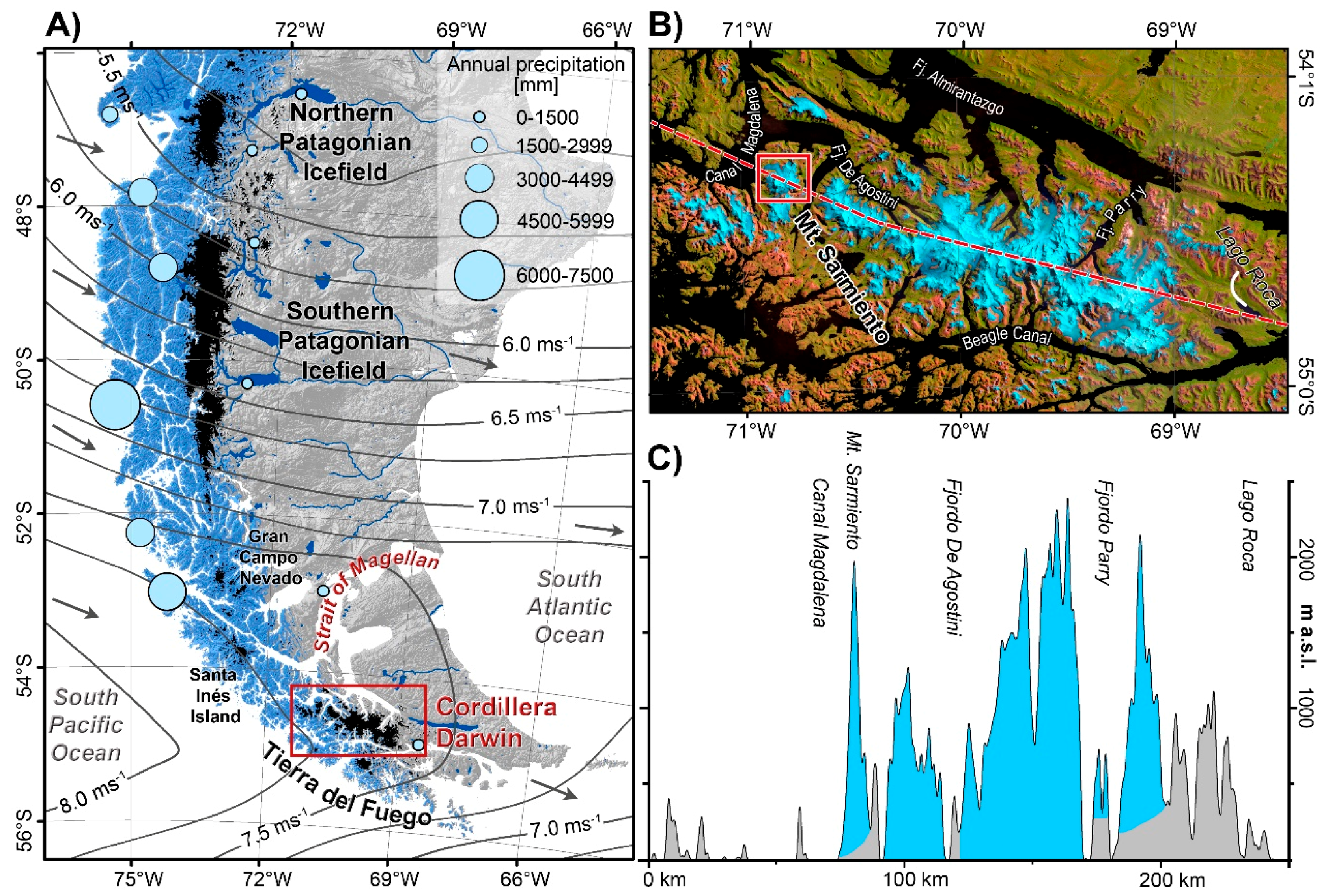


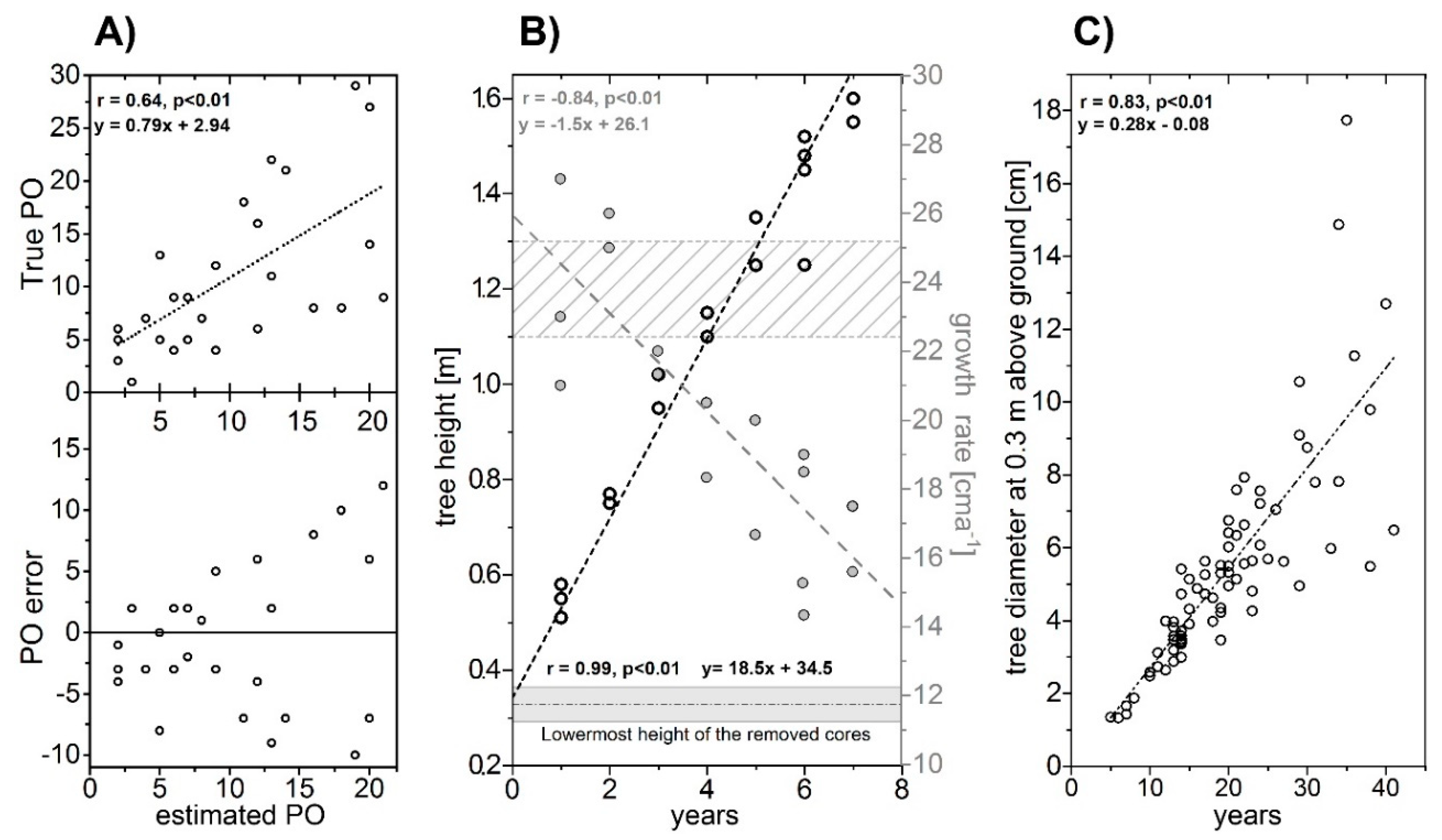
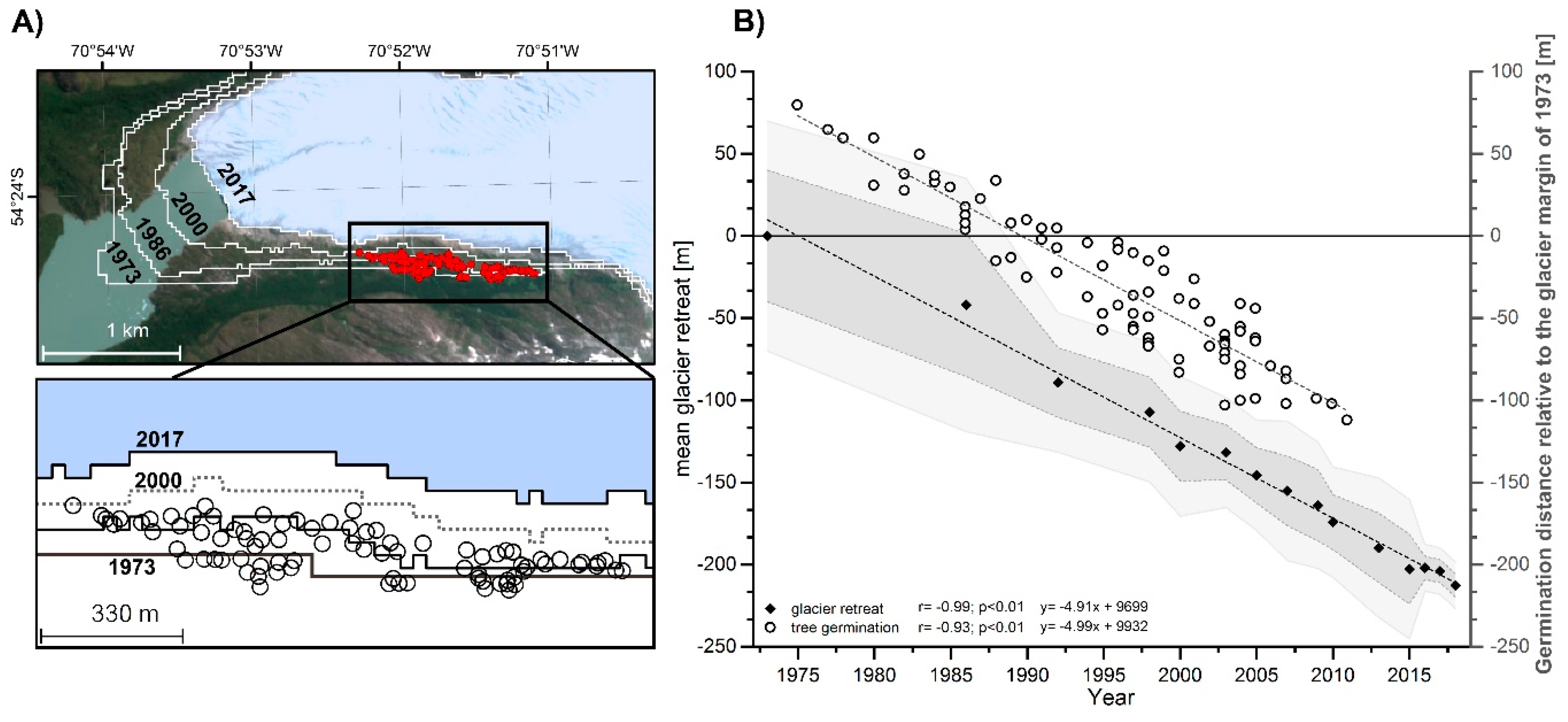
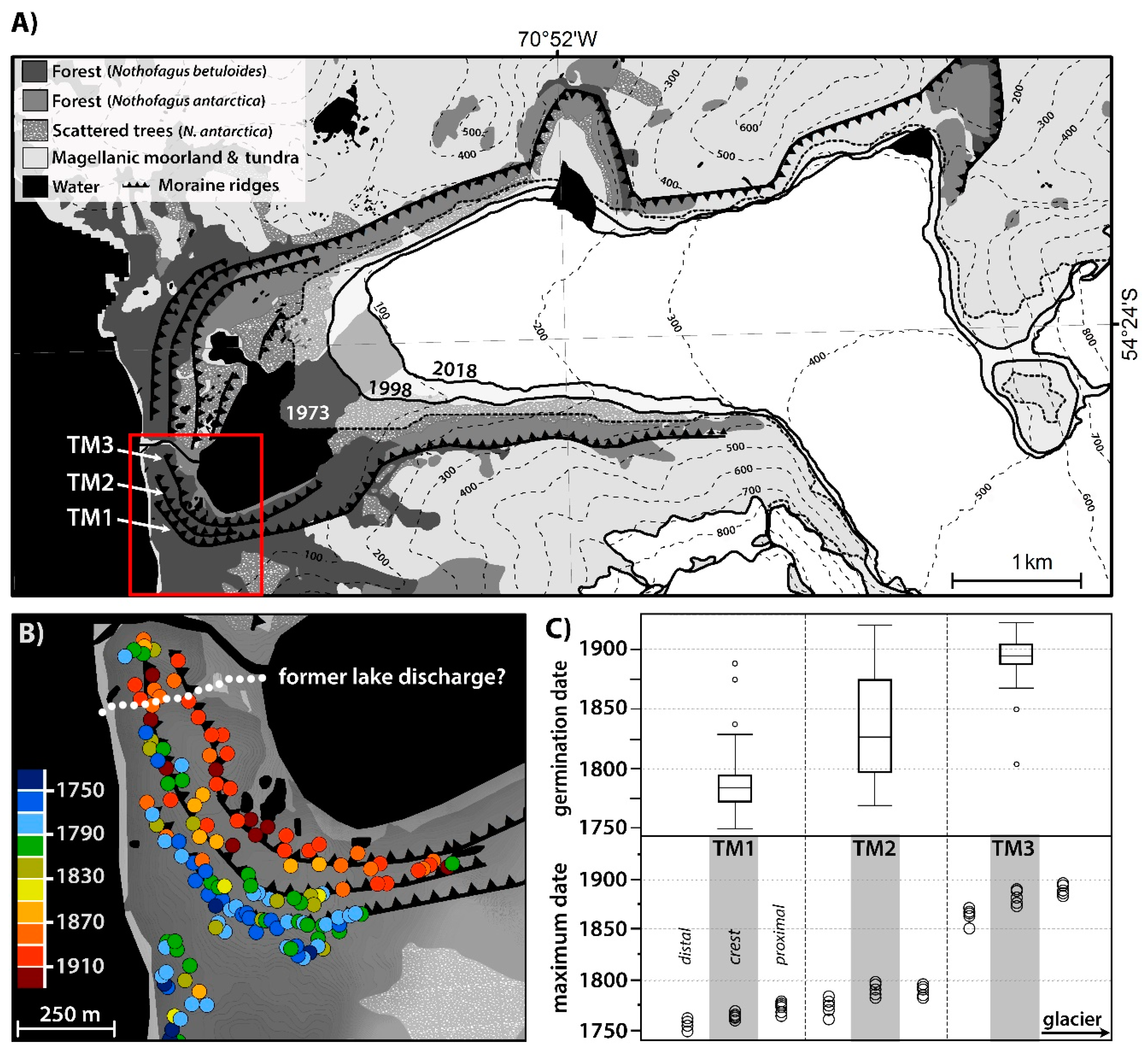
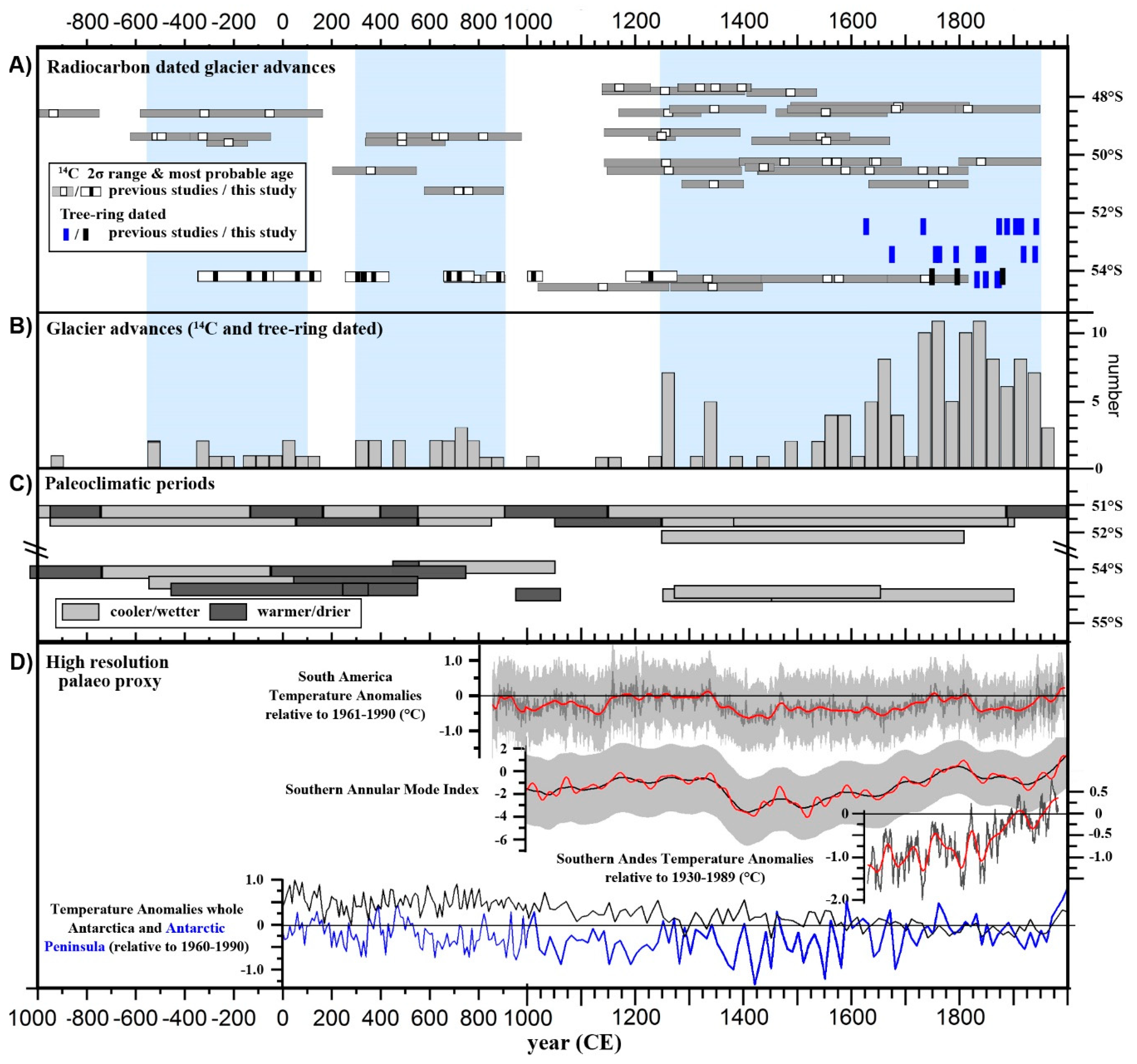
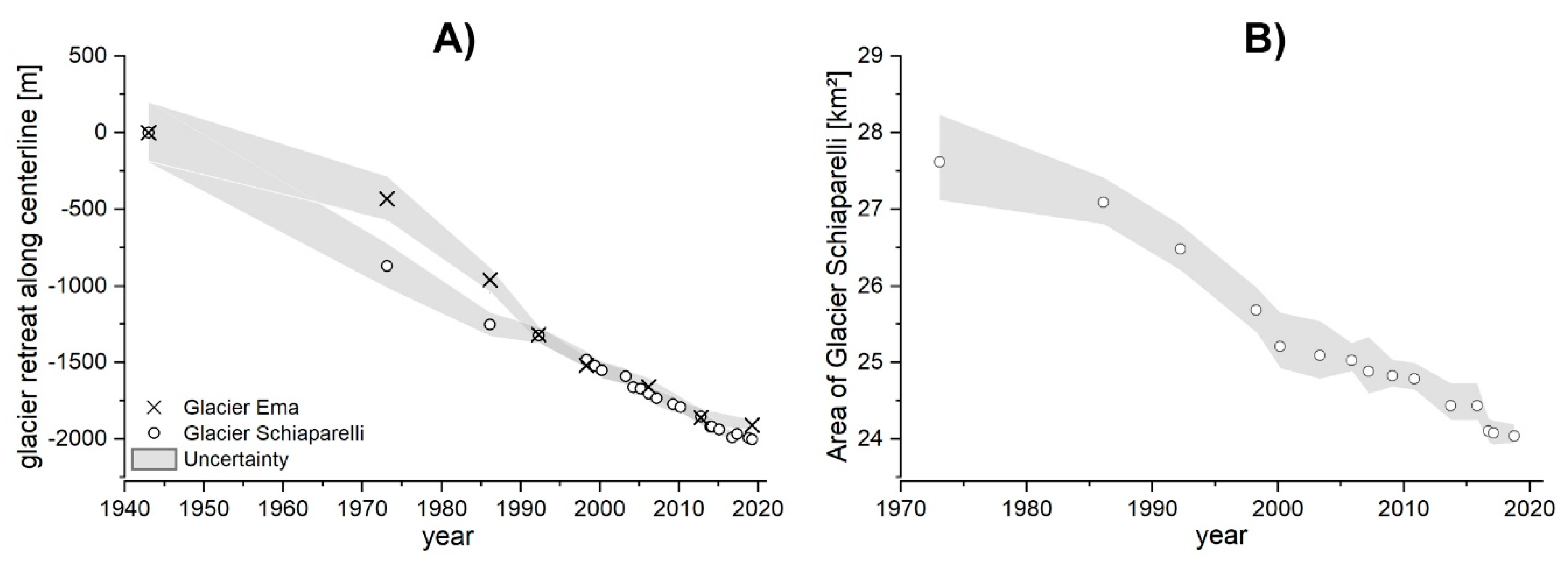
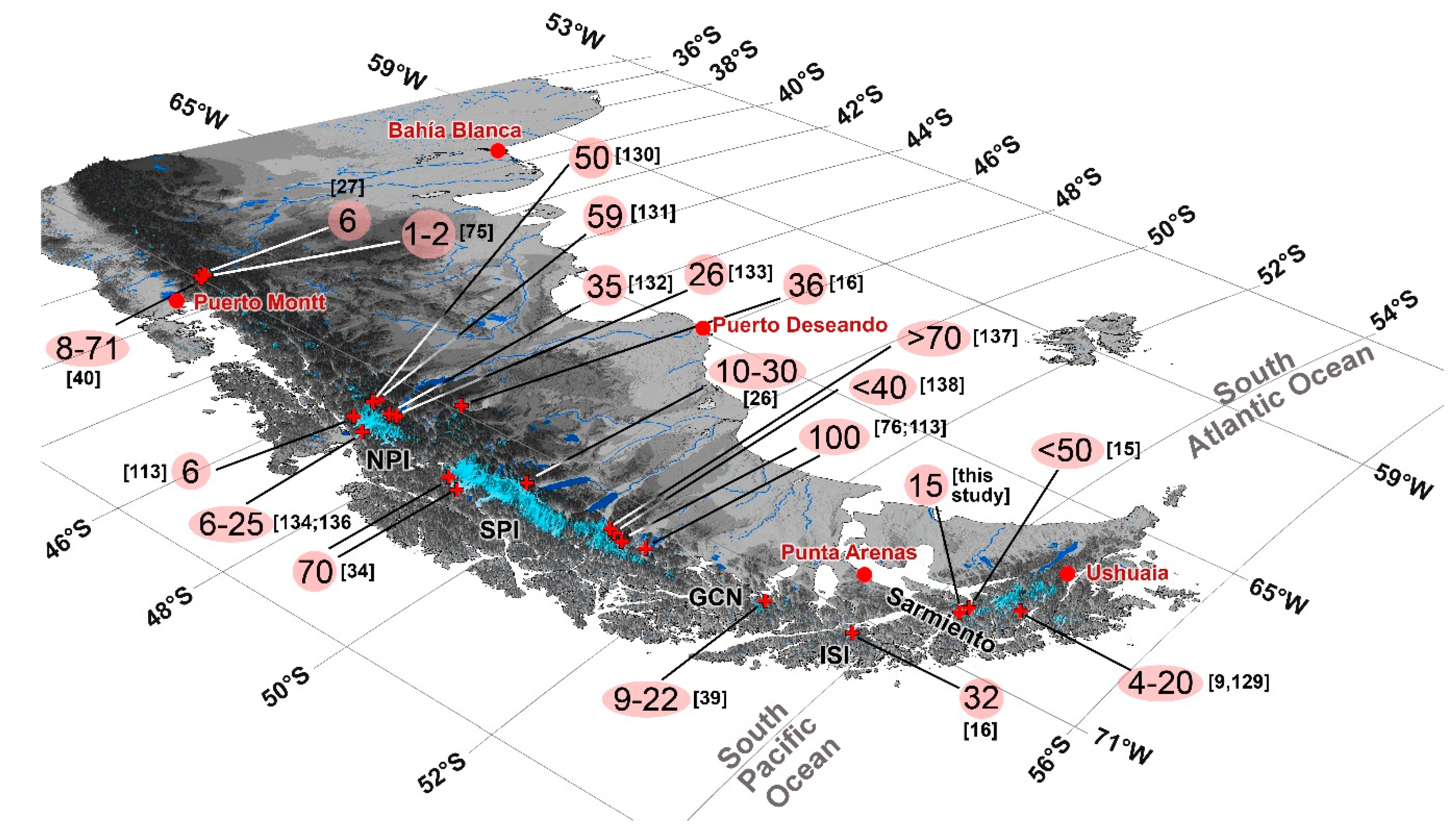
| NO | Uncal. Age (14C BP) | Cal. Age (cal ka BP) | Cal. Age (cal BCE/CE) | NO | Uncal. Age (14C BP) | Cal. Age (cal ka BP) | Cal. Age (cal BCE/CE) | ||||||||
|---|---|---|---|---|---|---|---|---|---|---|---|---|---|---|---|
| SC 1 | 2255 ± 15 | 2.31 | (2.23) | 2.16 | −360 | (−280) | −208 | SC 8 | 1750 ± 30 | 1.70 | (1.62) | 1.56 | 250 | (330) | 390 |
| SC 2 | 2165 ± 15 | 2.15 | (2.11) | 2.04 | −210 | (−160) | −90 | SC 9 | 1725 ± 15 | 1.61 | (1.58) | 1.54 | 340 | (370) | 410 |
| SC 3 | 2100 ± 15 | 2.09 | (2.03) | 2.00 | −140 | (−80) | −50 | SC 10 | 1385 ± 15 | 1.30 | (1.28) | 1.27 | 650 | (670) | 680 |
| SC 4 | 1985 ± 35 | 2.00 | (1.90) | 1.83 | −50 | (50) | 130 | SC 11 | 1320 ± 15 | 1.27 | (1.23) | 1.18 | 680 | (720) | 770 |
| SC 5 | 1930 ± 15 | 1.89 | (1.84) | 1.80 | 60 | (110) | 150 | SC 12 | 1215 ± 15 | 1.11 | (1.07) | 1.05 | 840 | (880) | 900 |
| SC 6 | 1770 ± 20 | 1.70 | (1.65) | 1.59 | 250 | (300) | 360 | SC 13 | 1080 ± 15 | 0.96 | (0.94) | 0.93 | 990 | (1000) | 1024 |
| SC 7 | 1760 ± 35 | 1.71 | (1.64) | 1.56 | 240 | (310) | 390 | SC 14 | 860 ± 30 | 0.77 | (0.73) | 0.68 | 1180 | (1220) | 1270 |
© 2019 by the authors. Licensee MDPI, Basel, Switzerland. This article is an open access article distributed under the terms and conditions of the Creative Commons Attribution (CC BY) license (http://creativecommons.org/licenses/by/4.0/).
Share and Cite
Meier, W.J.-H.; Aravena, J.-C.; Grießinger, J.; Hochreuther, P.; Soto-Rogel, P.; Zhu, H.; Pol-Holz, R.D.; Schneider, C.; Braun, M.H. Late Holocene Glacial Fluctuations of Schiaparelli Glacier at Monte Sarmiento Massif, Tierra del Fuego (54°24′ S). Geosciences 2019, 9, 340. https://doi.org/10.3390/geosciences9080340
Meier WJ-H, Aravena J-C, Grießinger J, Hochreuther P, Soto-Rogel P, Zhu H, Pol-Holz RD, Schneider C, Braun MH. Late Holocene Glacial Fluctuations of Schiaparelli Glacier at Monte Sarmiento Massif, Tierra del Fuego (54°24′ S). Geosciences. 2019; 9(8):340. https://doi.org/10.3390/geosciences9080340
Chicago/Turabian StyleMeier, Wolfgang Jens-Henrik, Juan-Carlos Aravena, Jussi Grießinger, Philipp Hochreuther, Pamela Soto-Rogel, Haifeng Zhu, Ricardo De Pol-Holz, Christoph Schneider, and Matthias Holger Braun. 2019. "Late Holocene Glacial Fluctuations of Schiaparelli Glacier at Monte Sarmiento Massif, Tierra del Fuego (54°24′ S)" Geosciences 9, no. 8: 340. https://doi.org/10.3390/geosciences9080340
APA StyleMeier, W. J.-H., Aravena, J.-C., Grießinger, J., Hochreuther, P., Soto-Rogel, P., Zhu, H., Pol-Holz, R. D., Schneider, C., & Braun, M. H. (2019). Late Holocene Glacial Fluctuations of Schiaparelli Glacier at Monte Sarmiento Massif, Tierra del Fuego (54°24′ S). Geosciences, 9(8), 340. https://doi.org/10.3390/geosciences9080340








